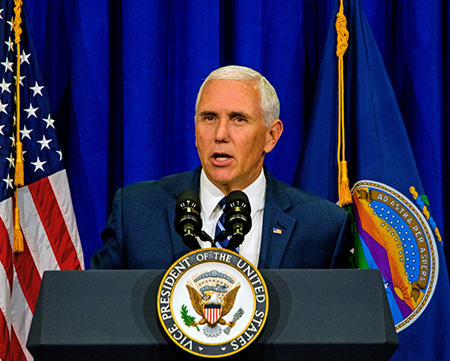Law prof's memo told Pence he could give Trump election win as 'ultimate arbiter' in elector count

Vice President Mike Pence speaks at an October 2018 event in Topoka, Kansas. Image from Shutterstock.
A conservative law professor wrote a memo telling then-Vice President Mike Pence how he could give then-President Donald Trump an election win when Congress counted Electoral College votes Jan. 6.
Then-Chapman University law professor John Eastman gave CNN a copy of the memo after the broadcast network published an earlier draft version.
Journalists Bob Woodward and Robert Costa had written about the memo in their new book, Peril, according to CNN and the Washington Post in stories noted by the Volokh Conspiracy.
“This election was stolen by a strategic Democrat plan to systematically flout existing election laws for partisan advantage,” Eastman argued in the memo. As Senate president, Pence is “the ultimate arbiter” in the electoral vote count, Eastman asserted.
Eastman announced his retirement from Chapman University on Jan. 14, after his Jan. 6 election fraud comments at a Women for America First rally provoked criticism. Eastman had claimed at the rally that “secret folders” placed inside voting machines could produce fraudulent votes.
In his memo to Pence, Eastman argued that there was “outright fraud” and improper election law changes in several key states, and that gave Pence the authority to make determinations that would give the election to Trump.
Eastman argued that there were competing sets of electors in those states—those who backed Trump and those who backed Joe Biden.
Actually, no state had put forth a second slate of electors, although Trump allies were making the competing electors claim, according to CNN.
In one of Eastman’s scenarios, Pence, acting as Senate president, could decide that he wouldn’t count electors in the several states, based on the theory that the election results had been called into question. Under the 12th Amendment, the vote count is based on appointed electors, and Pence could rule that there were no appointed electors in the states, Eastman said. That would leave 232 electoral votes for Trump and 222 for Biden.
In another scenario, Pence could determine that neither candidate has a majority and throw the election to the House of Representatives, with each state getting one vote.
“If the Republicans in the state delegations stand firm, the vote there is 26 states for Trump, 23 for Biden, and one split vote,” Eastman wrote.
In a third scenario, Pence would determine that election challenges must conclude before a vote count. If further investigation persuades state lawmakers that fraud affected the election, they could certify Trump electors and Trump would win.
Eastman told the Washington Post that his memo merely explored options that had been proposed. He told CNN that he had advised Pence to delay certifying the results in the key states, rather than declare Trump the winner, during an Oval Office meeting with Trump and Pence.
Eastman said he told Pence that it was unclear whether he could set aside slates of electors because no state had certified an alternative slate of electors, according to CNN.
Writing at the Volokh Conspiracy, Jonathan H. Adler, a professor at the Case Western Reserve University School of Law, sees problems with the memo.
According to Adler, the memo “relies on the false claim that there were ‘dual slates of electors’ transmitted to the Senate, adopts an expansive (and unjustified) interpretation of the vice president’s authority under the 12th Amendment, and urged Vice President Pence to unilaterally disregard” federal law on counting electoral votes.
Write a letter to the editor, share a story tip or update, or report an error.


